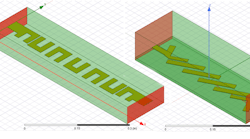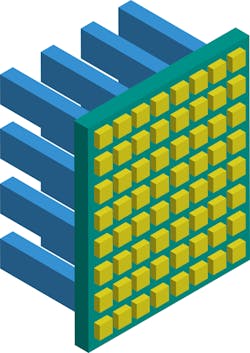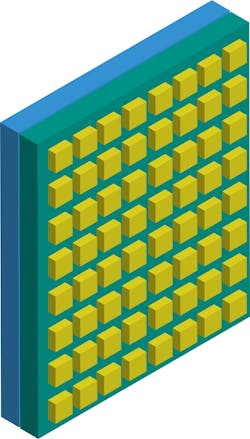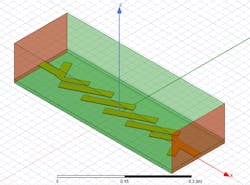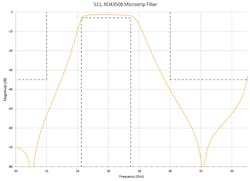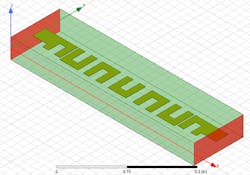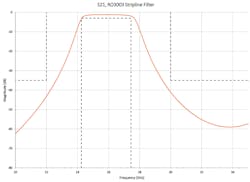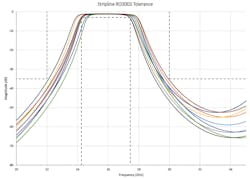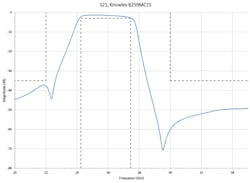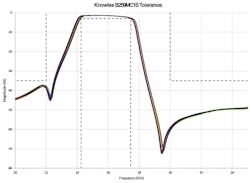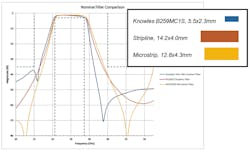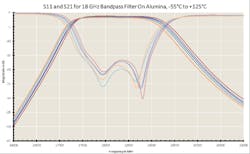Addressing Size and Tolerance Challenges in mmWave Filters
Download this article in PDF format.
In the race to implement mainstream 5G wireless communications, focus has shifted to increasing bandwidth capacity using frequencies greater than 20 GHz in the millimeter-wave (mmWave) spectrum. Because of the known range and path loss limitations of high frequencies, mmWave signals require much smaller antennas, which can be tightly packed together to create a single, narrowly focused beam for point-to-point communication with greater reach.
The design challenge becomes finding the right RF filter technology that can fit into the size constraints of integrated beamforming antennas. In addition, the filter’s manufacturing tolerances and temperature stability can also affect bandwidth capacity.
The Size Constraints of mmWave Technology
In a traditional antenna-array system, an inter-element spacing of less than half the wavelength (λ/2) is required to avoid the generation of grating lobes. This principle holds true in a 5G beamforming antenna in which, for example, a 28-GHz band antenna would need approximately 5 mm of inter-element spacing. Such a requirement, therefore, calls for very-small-form-factor components in the array.
Phased arrays used in mmWave applications are commonly designed in a plank architecture, such that the antennas (gold area) are mounted in a printed-circuit-board (PCB) (green area) and the circuit “planks” (blue area) are attached 90 degrees from the array. Space is already tight on these circuit planks, but now manufacturers are considering a more compact flat-panel architecture, which means filtering and other circuit blocks would need to be even smaller to fit directly on the back of the antenna PCB (Fig. 1).
1. Different mechanical approaches can be taken to implement phased-array antennas.
Impact of Manufacturing Tolerances for mmWave Filters
Considering the importance of miniaturizing mmWave filters, manufacturing tolerance plays a crucial role. Tolerance not only affects filter specifications (i.e., planned versus realized performance) and potential loss of bandwidth, but it also impacts the cost of implementation if one considers the cost of rejecting out-of-compliance boards. Plus, poor tolerance encroaches on potential board space or layers that could be used for adding other devices or functionality. To further examine these factors, we compared three different 26-GHz filter manufacturing approaches:
- Integrated microstrip approach on PCB
- Integrated stripline approach on PCB
- Thin film microstrip in a small-form-factor surface-mount (SMT) package
Discussions in the public domain1 use Monte Carlo methods with very aggressive tolerances compared to the typical tolerances that are seen in production. In general, similar results were observed with our simplified worst-case analysis, which aimed for the reasonably tight manufacturing parameters seen in the table.
Tolerance Impact on PCB Microstrip Filters
The design of the PCB microstrip bandpass filter (BPF) in Figure 2 was implemented with a sixth-order, edge-coupled topology on 10 mil of RO4350B laminate and 2-oz. electrodeposited (ED) copper for metallization.
2. This is a PCB microstrip implementation of a 26-GHz BPF.
Because of the inherent transmission zeros produced by the edge-coupled microstrip filter, the nominal design passes the close-in rejection requirements with margin (Fig. 3). Although the passband shows less margin and the high-side harmonic response is less than ideal, we chose not to further tune the design, since adding complexity drives up insertion loss and sensitivity to tolerances.
3. The simulated nominal design performance of a PCB microstrip 26-GHz BPF reveals that the filter passes the close-in rejection requirements.
To study tolerance impact on this hypothetical PCB microstrip filter, eight versions of the design were created with varying substrate thickness, etching tolerance, and dielectric constant tolerance—all within the limit lines. Figure 4 shows a significant shift in the filter’s low-side performance for both the rejection and 3-dB points.
4. The simulated tolerance response of the PCB microstrip 26 GHz BPF shows a significant shift in performance.
Also, the low side of the 35-dB common-mode rejection point shifted over by 2 GHz. Based on this simplified worst-case analysis, such a filter is unusable in manufacturing due to the variation over tolerance. In fact, the entire PCB would be rendered out of specification even before measuring performance variation due to other components and factors.
Tolerance Impact on PCB Stripline Filters
The design of the stripline approach in Figure 5 is a seventh-order hairpin with 30 mil of RO3003 laminate on the top and bottom, and 0.5 oz. of rolled (RA) copper.
5. Shown is a PCB stripline implementation of a 26-GHz BPF.
The hairpin stripline design does not have as steep of a skirt as the edge-coupled microstrip filter. Plus, the same harmonic performance challenges on the high side of the stopband were seen, as was the case with the PCB microstrip filter (Fig. 6).
6. This is the simulated nominal design performance of the stripline 26-GHz BPF.
Like the previous PCB microstrip experiment, eight variations of the stripline filter were created, varying in substrate thickness, etching tolerance, and dielectric material tolerance within the ranges stated in the table. The worst-case analysis in Figure 7 reveals a smaller shift in filter performance compared with the PCB microstrip design. However, tolerance margin must still be added to the target specification to allow for the variation in frequency response. For example, the low side of the 35-dB point is shown to fluctuate by approximately 1 GHz.
7. The simulated tolerance response of a stripline 26-GHz BPF indicates a smaller shift in filter performance than the microstrip design.
Tolerance Impact on SMT Microstrip Filters
For the surface-mount microstrip implementation, the Knowles Precision Devices B259MC1S 26-GHz BPF was selected. The topology and material details are proprietary, but the same nominal simulated design performance and simulated tolerance response to the three tolerance variables are shown in Figures 8 and 9, respectively.
8. The plot illustrates the simulated nominal design performance of an SMT microstrip 26-GHz BPF.
9. Judging by the simulated tolerance response of a SMT microstrip 26-GHz BPF, one can see that it’s less sensitive to manufacturing tolerances.
Subjecting the simulated version of the SMT microstrip filter across the same three design variables revealed a much smaller sensitivity to manufacturing tolerances (Fig. 9, again). The simulated 35-dB attenuation shift at the low end is approximately 130 MHz. While the simulated filters do not threaten the stopbands, a small shift was observed in the static passband. However, given that these devices are discrete SMT components subject to quality testing, only filters within performance compliance are shipped to the end user, thus improving the pass rate of the entire circuit and saving overall costs.
Figure 10 compares the nominal performance of all three filter approaches, as well as the filter surface area. The compact SMT filter design takes up less than a quarter of the space allocated to PCB microstrip and stripline filters with the same target specifications. Also, considering the previous discussion on the importance of half-wavelength sizing for mmWave antenna arrays, only the SMT thin-film dielectric filter is smaller than the approximately 5.7-mm inter-element spacing required at 26 GHz.
10. The nominal design performance and size of all three filters are compared.
Impact of Temperature Stability on Bandwidth
As manufacturers continually push the spectral efficiencies of RF filters, these valuable advances in available bandwidth can be lost due to not only manufacturing tolerances, but also temperature variation. Millimeter-wave antenna arrays may be found operating in extreme cold or hot outdoor conditions, and heat dissipation issues may arise from the miniaturized, crowded circuitry. The filter must have the ability to perform within specification over a wide range of temperatures, with a good temperature stability of approximately 3 ppm/°C.
A key component of temperature stability in microstrip filters is the selection of substrate material. For example, Figures 11 and 12 compare the filter performance of two SMT designs for 18-GHz BPFs. One lot was manufactured with alumina board and the other lot with CF custom dielectric substrate. The filter responses were taken from temperatures ranging from −55 to +125°C.
11. This is the temperature response of a microstrip 18-GHz BPF on alumina.
12. The temperature response of a microstrip 18-GHz BPF on CF dielectric reveals a shift of only 17 MHz at the 35-dB rejection point.
At the 35-dB rejection point, the alumina-based filter shifts by 140 MHz, whereas the CF dielectric filter only displays a shift of 17 MHz at the 35-dB point. By designing with the right dielectric material and filter topology, temperature-stable SMT filters with high rejection and low loss can be produced.
Conclusion
Turning 5G wireless communication into a widespread reality requires mmWave filter technology for 20 GHz and higher. However, certain obstacles exist in terms of physical size, tolerances, and temperature stability. Variation in production quality may result in significant loss of performance from the simulated design to the real-world manufactured part, thereby diminishing the gains from using the mmWave spectrum.
As a result, one must carefully consider tolerances and the need for guard bands for the design. In general, SMT devices are shown to provide better shipped tolerances compared with the PCB approach, as long as the impact of the SMT filter’s temperature stability on bandwidth capacity is taken into account.
Peter Matthews is Technical Marketing Manager at Knowles Precision Devices.
Reference
1. On mm-wave filters and requirement impact, 3GPP TSG-RAN WG4 meeting #85, R4-1712718.
